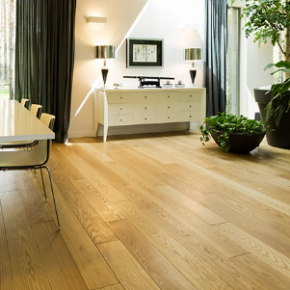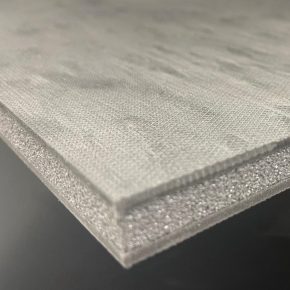
Engineered Wood Flooring Vs Hardwood Flooring – Lifestyle Flooring investigate
Lifestyle Flooring have taken a look at the essential difference between engineered wood flooring and hardwood flooring, with the intention of it helping people make informed decisions.
Engineered and hardwood both feature solid wood, but the way they are built and the features they possess make them entirely different. The type of floor chosen will depend a lot on the space, where you want to use the floor in and the way it is used.
Manufacture
Engineered wood floors feature a multi-layer design. The top layer, also called the wear layer, features solid wood, while the core layer is made of solid hardwood, softwood or plywood.
The number of layers used varies from each manufacturer and can range from two layers to twelve layers. All layers are bonded to each other under specific temperature and pressure.
Solid hardwood flooring, on the other hand, consists of solid hardwood planks derived from a single unit of lumber through factory machining.
Re-Sanding Capability
Engineered wood floors are available in varying degrees of thickness, ranging from 1mm to 5mm. The thicker the wear layer, the more the floor can be re-sanded.
Most solid hardwood floors are available in a standard thickness of ¾inch. However, some floors are thinner at 5/16” thickness. These floors can be re-sanded multiple times without compromising their structural integrity.
Usage for Engineered Wood & Hard Wood
Thanks to their layered construction, engineered wood floors can be installed anywhere in a building including the basement. The layered construction of the floors imparts excellent dimensional stability to them.
This means that these floors do not bulge or shrink owing to temperature and humidity changes. Engineered wood floors can be used in basements, conservatories and kitchens, without a second thought.
However, solid hardwood flooring is not resistant to such changes, meaning it is not recommended for moisture-prone areas like basements. They are ideally suited for above-level floors such as first, second and third levels.
If a consistent look is desired, an engineered wood floor would be a better option.
Performance
Engineered wood floors are constructed to offer better resilience than solid hardwood floors. You will find engineered floors are sturdier and better-performing compared to solid hardwood floors. With right maintenance, they can last a lifetime.
Solid hardwood flooring is great to have, but the performance depends on the type of solid wood. For example, a pine floor is a poor selection for areas experiencing heavy traffic or in kitchens and households with kids and active pets.
In spaces such as these, denser woods are appropriate, as they can handle scratches and dents better.
Whether it be engineered wood floors or hardwood floors, Lifestyle Flooring offers a fine selection of high-quality flooring, from some of the best manufacturers worldwide. We encourage people request free samples before an order is placed, so a more informed decision can be made.
One comment on “Engineered Wood Flooring Vs Hardwood Flooring – Lifestyle Flooring investigate”
Leave a Reply
You must be logged in to post a comment.
Latest news

30th April 2024
ASSA ABLOY Door Group strengthens offering with partnership
ASSA ABLOY Door Group is proud to announce a new internal restructure that sees the company joining forces with all comparable business units across Europe, the Middle East, India and Africa, to form a new global division – the ASSA ABLOY EMEIA Door Business Segment.
Posted in Access Control & Door Entry Systems, Architectural Ironmongery, Articles, Building Associations & Institutes, Building Industry News, Building Products & Structures, Building Services, Doors, Facility Management & Building Services, Restoration & Refurbishment, Retrofit & Renovation, Security and Fire Protection
30th April 2024
Geberit exhibiting at British Pig & Poultry Fair 2024
Bathroom and piping manufacturer Geberit will be exhibiting at the British Pig & Poultry Fair at NEC Birmingham (15 – 16 May 2024).
Posted in Articles, Building Industry Events, Building Industry News, Building Products & Structures, Building Services, Exhibitions and Conferences, Facility Management & Building Services, Innovations & New Products, Pipes, Pipes & Fittings, Plumbing, Retrofit & Renovation
29th April 2024
Hush: New Hushlay options offer acoustic upgrade potential
Leading UK acoustic systems manufacturer Hush Acoustics has introduced two additional variants of its Hushlay Soundmatting product.
Posted in Acoustics, Noise & Vibration Control, Articles, Building Industry News, Building Products & Structures, Building Services, Facility Management & Building Services, Floors, Innovations & New Products, Insulation, Restoration & Refurbishment, Retrofit & Renovation
29th April 2024
Digital Construction Week 2024 speaker programme announced
The programme at Digital Construction Week is carefully designed to help you keep up with the fast pace of innovation in the built environment.
Posted in Articles, Building Industry Events, Building Industry News, Building Products & Structures, Building Services, Exhibitions and Conferences, Innovations & New Products, news, Posts, Restoration & Refurbishment, Retrofit & Renovation, Seminars, Sustainability & Energy Efficiency

Are your product lines similar in appearance between engineered wood and hardwood? When I think of layered my first thought is how plywood is layered. Is the engineered wood similar of this in appearance?